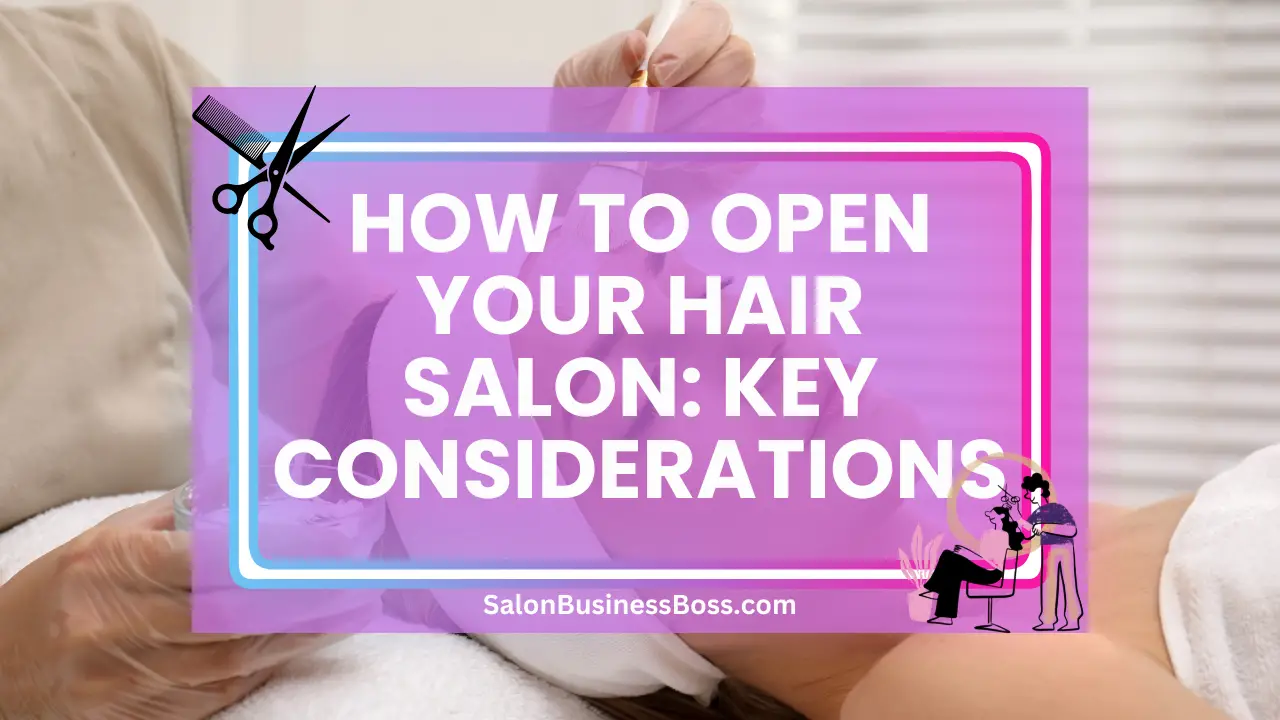Opening your own hair salon is an exciting and rewarding venture for those passionate about hairstyling and entrepreneurship. However, it’s crucial to approach this endeavor with meticulous planning and preparation to ensure long-term success.
To open my own hair salon, I need to get organized with a clear vision and business plan. Keeping detailed records, analyzing competition, and understanding risks and rewards are crucial. Selecting a prime location and hiring a skilled team will be key. Designing a stylish and client-friendly space and will ensure success.
Get Organized
1. Define Your Vision and Goals
Crafting a clear vision for your hair salon is the foundation of your journey as an entrepreneur. Envision the type of salon you wish to establish – whether it’s a high-end boutique with luxurious services, a trendy urban space catering to the fashion-forward crowd, or a warm and welcoming family-friendly salon. Aligning your goals with this vision will provide you with a sense of direction and purpose throughout the process.
By determining your salon’s identity early on, you can make informed decisions regarding its location, interior design, services offered, and branding. Remember, your vision should not only be about making profits but also creating a salon experience that resonates with your passion for hairstyling and your desired clientele. This vision will be the guiding force that drives your passion and dedication as you bring your hair salon dream to life.
2. Develop a Business Plan
A well-structured business plan is your roadmap to success in the competitive salon industry. Outline a clear mission statement that defines your salon’s purpose and values. Conduct a thorough analysis of your target market, identifying demographics, preferences, and needs.
A competitive analysis will help you understand your competitors’ strengths and weaknesses, allowing you to position your salon uniquely. Develop effective marketing strategies to reach and attract your target audience, leveraging both online and offline channels.
Financial projections are essential for estimating start-up costs, monthly expenses, and revenue forecasts. This will assist you in securing funding and ensuring your salon’s financial stability in the long run. Operational plans should detail the daily activities, salon management, and customer service practices to ensure smooth operations.
A comprehensive business plan showcases your professionalism and commitment to your salon’s success, making it a valuable tool for gaining support from potential investors and lenders.
3. Secure Funding
Assessing the financial requirements of opening and running your salon is a crucial step in turning your vision into reality. Calculate start-up costs, including lease payments, equipment purchases, salon supplies, and initial marketing expenses.
Explore various funding options to secure the necessary capital. This may include utilizing personal savings, approaching family and friends for investment, seeking bank loans, or reaching out to potential investors who believe in your vision.
Having a clear financial plan that highlights the expected return on investment and repayment strategies instills confidence in potential backers. Demonstrating a realistic approach to budgeting and expense management can help you secure the funding needed to launch and sustain your hair salon. Remember, financial stability is vital for managing day-to-day operations and investing in future growth opportunities.
Keep Detailed Records
1. Financial Management

Maintaining meticulous financial records is essential for the success of your hair salon. From the moment you open your doors, track all income, expenses, and profits using reliable accounting software. Regularly updating and reviewing these records will provide valuable insights into the financial health of your salon, enabling you to make informed decisions.
By tracking income, you can identify peak seasons and popular services, allowing you to optimize your offerings and marketing strategies accordingly. Monitoring expenses helps you identify areas where cost-cutting measures can be implemented, ensuring efficient resource allocation. Additionally, keeping track of profits allows you to gauge the success of various initiatives and determine the overall profitability of your salon.
Effective financial management also helps in budgeting and forecasting future growth. By analyzing financial data, you can spot trends and potential challenges, allowing you to take proactive measures to address them. Overall, meticulous financial records are crucial for maintaining a stable and thriving hair salon.
Read more about: Flourish Financially with Your Hair Salon
2. Employee Records
Establishing a streamlined system for managing employee records is essential for smooth salon operations. Create and maintain detailed records for each employee, including employment contracts, payroll information, and performance evaluations.
Accurate employee records ensure compliance with labor laws and regulations, protecting both you and your team. Contracts should outline job roles, responsibilities, and compensation, reducing the risk of misunderstandings or disputes. A well-organized payroll system ensures timely and accurate payment to your employees, fostering trust and loyalty within the team.
Performance evaluations are valuable tools for providing feedback, identifying areas for improvement, and recognizing exceptional work. This process helps in employee development, promoting a culture of continuous learning and growth within your salon.
Keeping comprehensive employee records facilitates seamless communication and fosters a positive work environment. As your salon grows, organized employee records become even more critical for managing an expanding team efficiently.
3. Client Information
Implementing a customer relationship management (CRM) system is a game-changer for your hair salon. This software allows you to store and track client information, preferences, and feedback in one centralized location.
By keeping detailed client records, you can offer personalized services tailored to individual needs and preferences. For example, knowing a client’s favorite haircare products or preferred hairstyle enables your stylists to provide a personalized and memorable experience, increasing customer satisfaction and loyalty.
The CRM system also aids in building strong customer relationships by allowing you to keep in touch with clients through personalized communications, promotions, and reminders for upcoming appointments. You can collect feedback and reviews, addressing any concerns promptly, and demonstrating your commitment to customer satisfaction.
Analyze Your Competition
1. Market Research
Thorough market research is crucial before opening your hair salon. Dive deep into the local market to understand your competition, target audience, and industry trends. Analyze the services and pricing of nearby salons, identifying gaps that your salon can fill. These gaps could be unmet customer needs, underserved demographics, or untapped niches. Leveraging this knowledge, develop unique selling points that set your salon apart from the competition.
Understanding your target audience’s preferences and demands will enable you to tailor your services and marketing efforts effectively. Stay updated on industry trends and emerging technologies to remain competitive and innovative. Comprehensive market research will equip you with valuable insights, increasing the chances of your salon’s success in a dynamic and competitive market.
2. SWOT Analysis
Performing a SWOT analysis is a strategic tool to evaluate both your salon and competitors objectively. Identify your salon’s Strengths, such as highly skilled stylists or a convenient location. Recognize Weaknesses, such as limited service offerings or inexperienced staff, which need improvement.
Explore Opportunities, like expanding into adjacent services or targeting a niche clientele. Analyze potential Threats, such as new competitors or economic downturns, to develop contingency plans.
Conducting a SWOT analysis for competing salons helps identify areas where you can outperform or differentiate yourself. Capitalize on your salon’s strengths and opportunities, while mitigating weaknesses and threats, to create a sustainable advantage in the market.
3. Learn from Successful Salons

Studying successful salons in other regions or cities provides valuable insights into best practices and winning strategies. Observe their branding, customer service, and marketing efforts to understand how they attract and retain customers.
Adapt these learnings to suit your salon’s unique needs and goals. Implement successful strategies while infusing your salon’s personality and vision to create an authentic and appealing brand.
Learn from both local and international success stories, as innovative ideas may transcend geographical boundaries. Embrace the concept of continuous improvement and be open to incorporating new techniques or services that have proven successful elsewhere. By learning from others, you can build a solid foundation for your salon’s success and foster a strong reputation in the industry.
Read more about: Dollars and Scissors: Evaluating Hair Salons’ Profit Potential
Understand the Risks & Rewards
1. Financial Risks
Launching a hair salon entails several financial risks that must be managed carefully. Initial investments, including lease deposits, equipment purchases, and salon decor, can be substantial. Additionally, overhead costs like rent, utilities, staff salaries, and inventory must be accounted for in your budget.
The unpredictable nature of the salon industry can lead to revenue fluctuations, especially during slower periods or unforeseen circumstances. To mitigate financial risks, establish a contingency fund to cover unexpected expenses and maintain a sound financial plan. Regularly monitor your salon’s financial performance, identify areas for cost optimization, and implement strategies to maximize revenue. With prudent financial management and risk assessment, you can navigate potential challenges and ensure the long-term sustainability of your hair salon.
2. Time and Commitment
Running a successful hair salon demands significant time and commitment from the owner. Especially during the initial phase, you will need to invest considerable effort into building your salon’s brand, clientele, and reputation. Be prepared to dedicate long hours to supervising salon operations, managing staff, and handling administrative tasks.
As an entrepreneur, your commitment to delivering exceptional customer service, staying updated on industry trends, and fostering a positive work environment is vital. You may also need to adapt to unforeseen situations and quickly address challenges as they arise. Balancing work and personal life can be demanding, so finding a support system or delegating responsibilities when necessary can alleviate the burden. Remember, the time and commitment invested in your hair salon will directly impact its growth and overall success.
3. Rewards of Entrepreneurship
Despite the financial risks and time commitment, owning a successful hair salon offers rewarding experiences that extend beyond monetary gains. The satisfaction of seeing your vision come to life and creating a space where clients feel pampered and valued is immensely fulfilling.
Entrepreneurship allows you to make a positive impact on people’s lives by helping them look and feel their best. Developing strong client relationships and becoming an integral part of their self-care routines can be deeply gratifying.
Select the Perfect Location
1. Assess Foot Traffic
Choosing a location with ample foot traffic is crucial for attracting potential clients to your hair salon. Look for areas with high pedestrian activity, such as busy streets, shopping malls, or commercial centers. Easy accessibility, proximity to public transportation, and parking facilities also play a significant role in attracting clients.
A location with high visibility enhances brand exposure, drawing more attention to your salon’s presence. Potential clients passing by are more likely to notice your salon and be enticed to explore your services. The convenience of an easily accessible location can also encourage spontaneous walk-ins, boosting your customer base and revenue potential. Conduct thorough research and market analysis to identify areas with favorable foot traffic and ensure that your salon becomes a go-to destination for hairstyling services.
2. Know Your Target Market

Understanding your target market is essential when selecting a salon location. Consider the demographics, preferences, and lifestyle of your ideal clientele. For example, if your salon aims to cater to a younger, fashion-forward crowd, locating in a trendy urban area or near college campuses may be ideal.
On the other hand, if you want to serve families and professionals, a suburban neighborhood with a relaxed atmosphere could be more suitable. Your salon’s ambiance and services should align with the surrounding community to attract and retain clients.
Demographic data and market research can provide valuable insights into the needs and desires of your target market. By choosing a location that resonates with your ideal clients, you increase the chances of creating a strong customer base and thriving in the long run.
Read more about: How to Open Your Own Hair Salon: Embrace Your Hair Artistry
3. Competition and Neighboring Businesses
Conduct a thorough analysis of the competition in the area where you plan to open your salon. Evaluate the proximity of competing salons and their strengths and weaknesses. Identifying gaps in the market that your salon can fill will give you a competitive edge.
Assess the synergy with neighboring businesses as well. Being located near complementary businesses, such as beauty supply stores or boutiques, can lead to cross-promotional opportunities and drive more foot traffic to your salon. Collaborations and partnerships with nearby establishments can help you establish a local presence and expand your client base.
While some competition can be healthy, ensure that the concentration of salons in the area does not saturate the market. Striking the right balance between competition and collaboration will play a vital role in the success of your salon at its chosen location.
Hire the Right Team
1. Define Job Roles and Responsibilities
Establishing clear job roles and responsibilities is essential for the smooth functioning of your hair salon. Clearly define the tasks and duties of each team member, including stylists, assistants, receptionists, and other personnel. This ensures that everyone knows their specific responsibilities, reducing misunderstandings and overlaps.
When hiring, seek skilled professionals who align with your salon’s culture and values. A cohesive team with a shared vision fosters a harmonious work environment and enhances the overall client experience. Regularly communicate expectations and performance standards to maintain consistency and high-quality services.
Having well-defined job roles and hiring the right team members create a strong foundation for efficient salon operations, allowing your salon to deliver exceptional services and stand out in the competitive market.
2. Training and Professional Development
Investing in ongoing training and professional development programs for your team is a wise investment that yields long-term benefits. Regular training sessions keep your team updated on the latest hairstyling techniques, industry trends, and customer service skills.
Well-trained staff can provide high-quality services, leading to increased customer satisfaction and loyalty. Empower your team with the tools and knowledge they need to excel in their roles, enhancing their confidence and job satisfaction.
Offer opportunities for skill enhancement and specialization, such as advanced hairstyling courses or workshops. Recognize and celebrate employees’ achievements, motivating them to continuously improve and contribute positively to your salon’s growth.
By prioritizing training and professional development, your salon maintains a competitive edge, attracts top talent, and elevates its reputation in the industry.
3. Foster a Positive Work Environment
Creating a positive and supportive work environment is vital for employee satisfaction and productivity. Encourage open communication and establish channels for employees to voice their opinions and concerns. Listen to their feedback and implement necessary changes to address their needs.
Recognize and celebrate achievements, both big and small, to make employees feel valued and appreciated. Foster a culture of collaboration and teamwork, where everyone’s contributions are acknowledged and respected.
Provide opportunities for growth and career advancement, such as promotions or taking on additional responsibilities. Offer competitive compensation and benefits to attract and retain talented individuals.
A positive work environment promotes employee loyalty, reduces turnover, and leads to a more cohesive and motivated team. Happy employees are more likely to provide outstanding customer service, contributing to your salon’s success and reputation as a desirable workplace.
Design Your Salon Space
1. Reflect Your Brand

Your salon’s interior design serves as a visual representation of your brand and vision. Consider the image you want to convey and select elements that resonate with your salon’s identity. Choose a cohesive color scheme that complements your branding and creates a welcoming atmosphere.
Decorate the space with elements that reflect your salon’s personality and target audience. Whether it’s modern and sleek or cozy and rustic, ensure the design elements align with your brand’s image.
The salon’s layout should also reflect your vision. Arrange the space in a way that optimizes client flow and enhances the overall experience. Thoughtful interior design creates a lasting impression on clients, reinforcing your brand’s identity and fostering a positive perception of your salon.
Read more about: How to Open Your Own Hair Salon: Embrace Your Hair Artistry
2. Optimize Space Utilization
Efficient space utilization is vital for a well-organized and functional hair salon. Design the layout to accommodate various areas, such as styling stations, shampooing stations, waiting areas, and retail displays. Organize these spaces to promote a seamless workflow for your team and a pleasant experience for clients.
Consider the traffic flow within the salon and ensure that workstations are easily accessible to staff and clients. Create designated areas for each function to minimize clutter and distractions.
Invest in salon furniture and equipment that are space-efficient and enhance the salon’s overall design. Prioritize functionality and aesthetics, striking a balance between style and practicality.
An optimized salon layout not only enhances operational efficiency but also contributes to a more enjoyable and relaxing experience for your clients, encouraging repeat business and positive word-of-mouth.
3. Comfort and Ambience
Client comfort is a top priority in any successful hair salon. Create a warm and inviting ambiance that makes clients feel at ease from the moment they step in.
Invest in comfortable and stylish furniture, ensuring that waiting areas and styling stations are cozy and welcoming. Quality lighting is crucial for showcasing your work and creating a pleasant atmosphere. Choose lighting that complements your salon’s design and enhances the overall appearance.
Background music can add to the salon’s ambiance, creating a relaxing and enjoyable experience for clients. Consider using soft, soothing tunes that complement the salon’s vibe.
A comfortable and inviting environment encourages clients to relax and enjoy their salon experience. By prioritizing client comfort and ambiance, you foster a positive and memorable impression, leading to increased client satisfaction and loyalty.
Conclusion
Starting your own hair salon requires careful planning, dedication, and a customer-centric approach. By getting organized, maintaining detailed records, analyzing the competition, understanding risks and rewards, selecting the perfect location, hiring the right team, and designing a welcoming space, you can set the foundation for a successful and thriving hair salon. Remember, with a passion for hairstyling and an entrepreneurial spirit, your hair salon dream can become a reality.
Frequently Asked Questions

1. What marketing strategies can I use to promote my salon?
Utilize social media platforms, collaborate with local influencers, offer promotions, and participate in community events to increase brand visibility.
2. How can I create a positive work environment for my team?
Foster open communication, acknowledge employees’ efforts, and provide growth opportunities. Encourage teamwork and celebrate successes together.
3. What factors should I consider when selecting salon products and equipment?
Choose high-quality and reputable products, considering the specific needs of your salon and the preferences of your target audience.
To learn more on how to start you own salon checkout my startup documents here.
Please note that the contents of this blog are for informational and entertainment purposes only and should not be construed as legal advice. Any action taken based on the information provided in this blog is solely at your own risk. Additionally, all images used in this blog are generated under the CC0 license of Creative Commons, which means they are free to use for any purpose without attribution.

About the author. Entrepreneur and Salon Business Fan.
Hi! I am Shawn and I am a happy individual who happens to be an entrepreneur. I have owned several types of businesses in my life from a coffee shop to an import and export business to an online review business plus a few more and now I create online salon business resources for those interested in starting new ventures. It’s demanding work but I love it. I do it for those passionate about their business and their goals. That’s why when I meet a salon business owner, I see myself. I know how hard the struggle is to retain clients, find good employees and keep the business growing all while trying to stay competitive.
That’s why I created Salon Business Boss: I want to help salon business owners like you build a thriving business that brings you endless joy and supports your ideal lifestyle.

